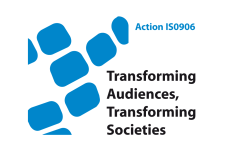- About the Action
- Events
- PhD workshop - Ljubljana 2014
- Action Open Conference - Ljubljana 2014
- New Media and Participation conference - Istanbul 2013
- Belgrade meeting 2013
- Media literacy research and policy - Brussels 2013
- ICA Pre-Conference 2013
- Tampere meeting 2013
- Budapest workshop 2012
- Milan meeting 2012
- Brussels PhD workshop 2012
- Brussels Action workshop 2012
- London meeting 2011
- Zagreb Conference 2011
- Lisbon meeting 2010
- Affiliated events
- WG 1
- WG 2
- WG 3
- WG 4
- Cross-WG
- Output
Teenage Uploaders on YouTube: Networked Public Expectancies, Online Feedback Preference, and Received On-Platform Feedback
Courtois, C., Mechant, P., and De Marez, L. (2011). Teenage Uploaders on YouTube: Networked Public Expectancies, Online Feedback Preference, and Received On-Platform Feedback . Cyberpsychology, Behavior, and Social Networking, 14(5), 315-322.
http://online.liebertpub.com/doi/abs/10.1089/cyber.2010.0225?prevSearch=Contrib%...Abstract: All Issues In This Issue Previous Article Next Article Cyberpsychology, Behavior, and Social Networking Not a subscriber? Get started... Teenage Uploaders on YouTube: Networked Public Expectancies, Online Feedback Preference, and Received On-Platform Feedback To cite this article: Cédric Courtois, Peter Mechant, and Lieven De Marez. Cyberpsychology, Behavior, and Social Networking. May 2011, 14(5): 315-322. doi:10.1089/cyber.2010.0225. Published in Volume: 14 Issue 5: June 1, 2011 Online Ahead of Print: November 30, 2010 Full Text HTML Full Text PDF (911.3 KB) Full Text PDF with Links (917.8 KB) Author information Cédric Courtois, M.A., Peter Mechant, M.A., and Lieven De Marez, Ph.D. IBBT-MICT-Ghent University, Department of Communication Sciences, Ghent, Belgium. Address correspondence to: Cédric Courtois, M.A. IBBT-MICT-Ghent University Department of Communication Sciences Korte Meer 7-9-11 9000 Ghent Belgium E-mail: cedric.courtois@ugent.be ABSTRACT Abstract This article focuses on teenage YouTube uploaders' networked public expectancies when posting a video. These expectancies allow uploaders to cope temporarily with the uncertainty of who exactly will view their video. The results indicate that teenage uploaders strongly expect viewers that are situated close to them in both geographic and socio-demographic terms. Furthermore, we discuss the uncertainty-reducing properties of online feedback. We propose that different types of online feedback are preferred to verify the prior networked public expectancies. An effect of the identified online public expectancy (viewers with a similar interest/activity) is found for the importance of feedback both on the platform (e.g., views, comments) and off the platform (e.g., interaction on a social-network site). The identified offline public expectancy (friends/family) affects the importance attributed to off-platform feedback. Surprisingly, no effect of the unidentified online public expectancy (the general public) was found on on-platform feedback. This finding, in conjunction with the low expectancy of this group, raises the question of whether teenagers either cannot conceive this ambiguous mass public, or, if their expectancies are accurate, whether they are aware of the fact that only a small fraction of the videos on YouTube reach notable popularity. Therefore, in a second study, we test the accuracy of the online networked public expectancies by testing their effects on the longitudinal growth of actual feedback (views, comments, and rates). The results provide modest evidence that teenage uploaders have accurate online public expectancies.

